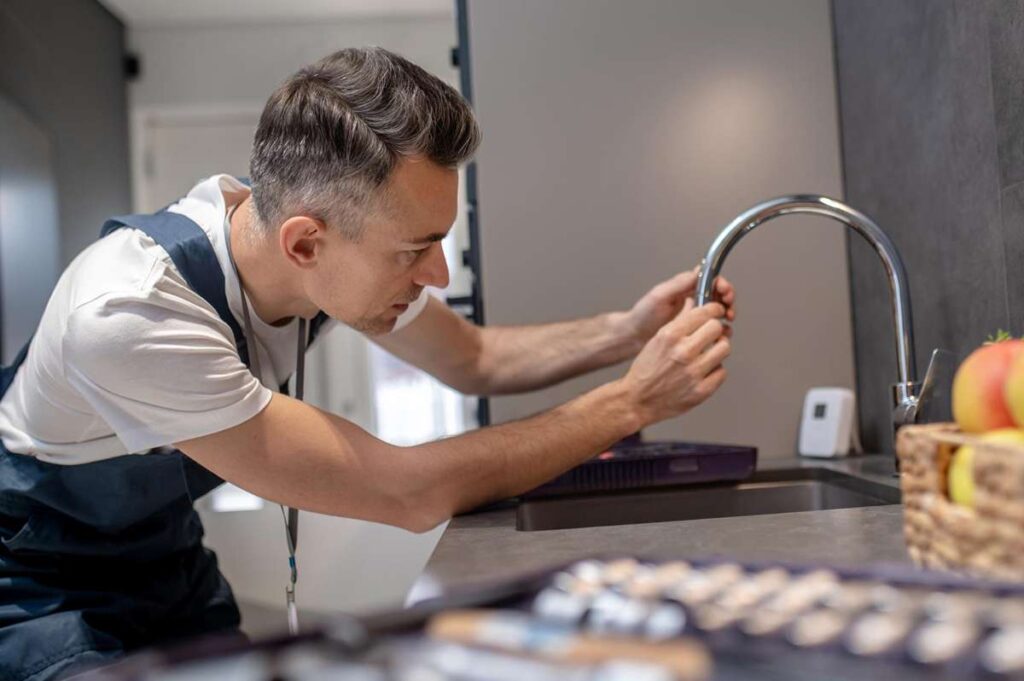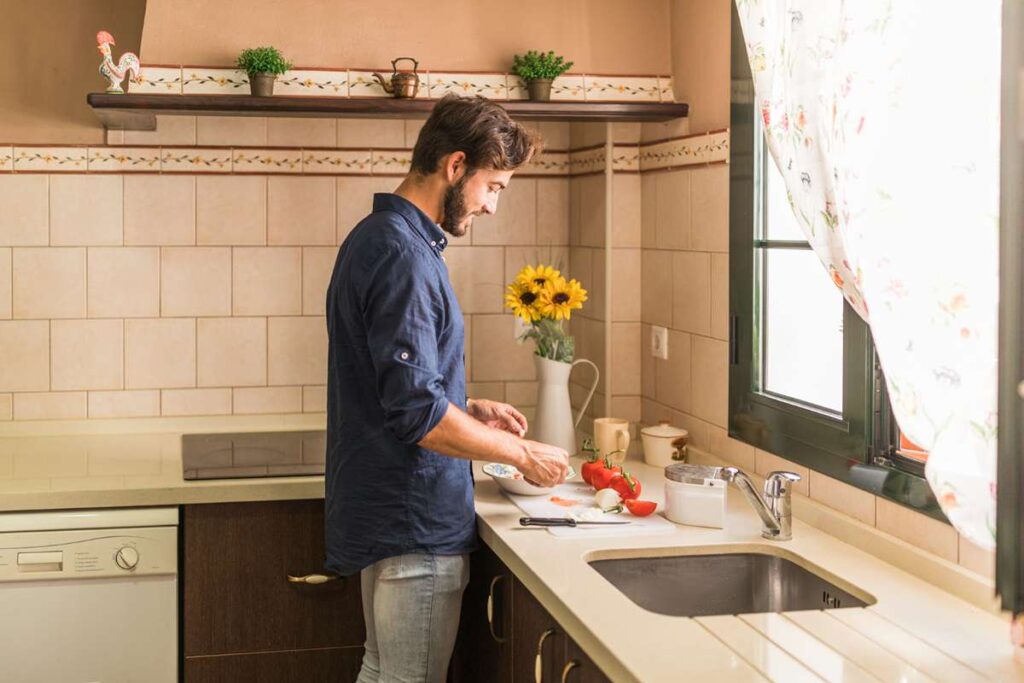Replacing a kitchen sink might seem tricky, but it’s easier than you think! Sometimes sinks get damaged, look outdated, or you just want an upgrade. If you’re wondering how to replace a kitchen sink without getting overwhelmed, you’re in the right place. In this guide, we’ll walk you through each step in a simple, clear way — easy enough for even a 5th-grader to understand!
Tools and Materials You’ll Need
Before you start learning how to replace a kitchen sink, it’s important to get everything ready. Having the right tools and materials on hand will save you a lot of time and avoid last-minute trips to the store. Let’s make sure you’re fully prepared!
Essential Tools
You’ll need a few basic tools to get the job done right:
- Adjustable wrench – for loosening and tightening nuts and bolts
- Screwdriver – for removing screws from the sink or faucet
- Plumber’s putty – to create watertight seals
- Pipe wrench – for stubborn plumbing connections
- Bucket – to catch any leftover water from the pipes
- Utility knife – to cut old sealant or caulk
- Safety gloves and glasses – to protect your hands and eyes while working
Materials
Make sure you have these materials ready before you start:
- New sink – choose one that matches your counter space
- New faucet (optional) – a great time to upgrade if needed
- Silicone sealant – for sealing around the sink edges
- New drain assembly – to ensure leak-free drainage
How to Prepare for Replacing Your Kitchen Sink
Before you jump into learning how to replace a kitchen sink, you need to prepare the area properly. Taking these careful steps will make the whole process smoother and help avoid any messy surprises.
Turn Off the Water Supply
First things first: you must turn off the water to your sink.
- Find the water shut-off valves under your sink.
- Turn both the hot and cold water valves clockwise until they are tightly closed.
- Turn on the faucet to check if the water has stopped flowing. This also helps release any pressure left in the lines.
Disconnect Plumbing and Drain Lines
Now it’s time to disconnect the plumbing carefully.
- Place a bucket under the drain pipes to catch any leftover water.
- Use an adjustable wrench to unscrew the water supply lines from the faucet connections.
- Gently loosen and remove the P-trap (the curved drainpipe) and set it aside.
After disconnecting everything, you’re ready to take out the old sink.
- Use a utility knife to cut through the old sealant around the edges of the sink.
- Find and loosen any clips or brackets holding the sink in place underneath the countertop.
- Carefully lift the sink out of the counter. It might be a little stuck, so move slowly to avoid damaging the counter.
Quick Tips Before Moving On
- Keep old parts like clips, screws, and brackets — they might help match sizes with your new sink.
- Take clear photos of the plumbing setup before disconnecting it. This makes reassembly much easier later!
Step-by-Step: How to Install the New Kitchen Sink

Now that you’ve removed the old sink, it’s time to install your brand-new one! Don’t worry — how to replace a kitchen sink is much easier when you take it one step at a time. Let’s get started.
Clean the Area
Before installing the new sink:
- Remove any old sealant and wipe away grime from the countertop opening.
- Make sure the surface is clean, dry, and smooth.
- This helps the new sink fit tightly and prevents leaks.
Install the Faucet and Drain First (Optional Tip!)
Here’s a smart trick:
- Install the faucet and drain assembly onto the sink before placing it into the countertop.
- It’s much easier to tighten parts when the sink isn’t squeezed into a small space!
- Follow the instructions that came with your new faucet and drain.
Place the New Sink
Time to fit your new sink:
- Apply a thin bead of plumber’s putty or silicone sealant around the edge of the sink or the countertop opening.
- Carefully lower the sink into the hole, making sure it’s centered and level.
Secure the Sink
To lock the sink in place:
- Attach the clips or brackets underneath the countertop as directed.
- Tighten the screws firmly, but don’t overtighten — you don’t want to crack your new sink!
Reconnect Water Supply and Drain Lines
Almost done!
- Reattach the water supply lines to the faucet.
- Reconnect the P-trap and other drain parts underneath.
- Tighten all connections securely with your wrench.
Check for Leaks:
- Slowly turn the water valves back on.
- Turn on the faucet and look underneath the sink for any drips.
- If you spot any leaks, gently tighten the connections a little more until everything is dry.
Common Mistakes to Avoid When Replacing a Kitchen Sink

While learning how to replace a kitchen sink, a few small mistakes can cause big problems. Here are the most common errors — and how you can avoid them!
- Forgetting to Turn Off the Water
Always shut off the water supply before you start. Forgetting this step can cause messy floods and a lot of extra cleanup! - Using the Wrong Size Sink
Not all sinks are the same size. Always measure your countertop opening carefully and double-check the size before buying your new sink. - Not Sealing Properly, Leading to Leaks
If you don’t apply plumber’s putty or silicone sealant correctly, water can leak around the edges of the sink. Take your time to seal everything tightly and evenly. - Over-tightening Fittings (Can Crack Pipes)
It’s important to tighten connections firmly — but not too hard! Over-tightening can crack pipes or damage fittings, leading to costly repairs later.
How to Troubleshoot Small Problems
Even when you know how to replace a kitchen sink, little issues can sometimes pop up. Don’t worry — here’s how to fix them quickly.
If You See Leaks
- Check all the connections under the sink.
- Use a wrench to gently tighten any loose nuts or fittings.
- If leaks continue, make sure the sealant around the sink edges is applied properly.
If Water Drains Slowly
- Look under the sink and check if the P-trap and pipes are installed correctly.
- A trap installed backwards or crooked can slow down water flow.
- If needed, disconnect the trap, clean it out, and reinstall it properly.
If Sink is Loose
- Open the cabinet under the sink.
- Find the mounting clips that hold the sink in place.
- Use a screwdriver to gently tighten them until the sink feels secure.
When Should You Call a Professional?
While many people can learn how to replace a kitchen sink by themselves, sometimes it’s smarter (and safer) to call an expert. Here’s when you should get help:
- Major Plumbing Changes Needed
If your new sink needs new pipes or moving drain lines, it’s best to hire a licensed plumber. Major changes can be tricky and must meet building codes. - Persistent Leaks
If you’ve tightened everything and sealed properly but water still leaks, a professional can quickly find and fix hidden problems. - Complicated Setups with Garbage Disposals or Dishwashers
Installing a garbage disposal or connecting to a dishwasher can get confusing. A pro knows exactly how to do it safely and correctly.
FAQS
Can you replace a kitchen sink yourself?
Yes, you can replace a kitchen sink yourself! With the right tools, a step-by-step guide, and some patience, it’s a totally doable DIY project. Just take your time and follow instructions carefully.
Can you replace a sink without replacing the countertop?
Absolutely! If the new sink fits the existing cutout in your countertop, you don’t need to replace the counter. Always measure carefully before buying your new sink.
Do you need a plumber to change a sink?
You only need a plumber if major plumbing changes are required. If you’re just swapping out a sink with similar connections, most homeowners can handle it themselves easily.
How to install kitchen sink step by step?
First, turn off the water and disconnect the old sink. Next, install the faucet and drain, place the new sink, secure it, and reconnect the pipes. Always check for leaks before finishing up.
How to measure sink size?
Measure the length, width, and depth of your current sink. Also, measure the size of the cutout in the countertop. This helps you buy a new sink that fits perfectly.
Do people still use plumber’s putty?
Yes! Plumber’s putty is still commonly used to create watertight seals around drains and faucets. It’s a must-have material for sink installations.
Can I replace a kitchen sink myself?
Yes, you can! Following a clear guide on how to replace a kitchen sink makes the job simple, even for beginners. Just be sure to prepare properly.
How long does it take to replace a kitchen sink?
For beginners, replacing a kitchen sink usually takes about 2–4 hours. If you have experience or simple connections, it could be even quicker.
How much does it cost to replace a kitchen sink?
DIY costs typically range between $100–$300 depending on the type of sink you choose. Hiring a professional will cost more based on labor and complexity.
Do I need a plumber to replace a sink?
You only need a plumber if there are big plumbing changes, like moving drain lines. For simple replacements, most people can complete it themselves.
Conclusion
Replacing your kitchen sink might sound scary, but it’s really just a few simple steps: turn off the water, disconnect the old sink, install the new one, and reconnect everything carefully. With this easy-to-follow guide on how to replace a kitchen sink, you can handle the job like a pro — even if it’s your first time! Take your time, follow each step, and you’ll have a brand-new sink shining in your kitchen in no time!










